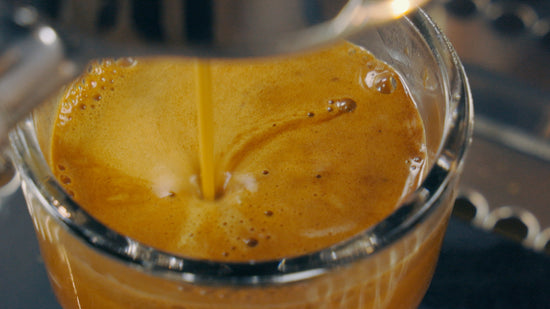What is Espresso Crema?

Crema is a big part of what makes espresso look so delicious and so different from the coffee produced by other brew methods. It’s a term that ties back to the very origins of espresso but what is it and what does it tell you about your shots? Find out in our brief video below.
Today, the term “espresso” is ubiquitous. If you ask for an espresso in a coffee shop just about anywhere in the world, odds are that the barista will understand you and that you’ll get what you expect, or at least something close. That wasn’t always the case. While there are earlier examples of espresso machines that bear that name, espresso as we know it today was first made by Gaggia in the 1940s. Needing a name for this new kind of coffee, Achille Gaggia, the inventor of the modern espresso machine, coined the term “caffé crema” which translates to cream coffee, due to the thick consistency and dense foam that topped the beverage. The name espresso, which predates crema caffé by at least a few decades, was the term that stuck but we still use the word crema to this day to describe that thick foam sitting atop our espresso.
So, what is crema? By volume, it’s mostly carbon dioxide gas. This gas is produced when coffee is roasted, at which point it remains trapped within the cell structure of the beans. When brewing coffee, water is forced to pass through this cell structure to flush out all the flavorful compounds that makeup coffee. In the process, they also end up forcing out carbon dioxide gas. With other brew methods - like pour over - this effect is referred to as a “bloom” as the bed of coffee expands with the expanding gas. In an espresso machine, there’s nowhere for this gas to go. It gets forced through the portafilter basket with the rest of the water and coffee solids. This forms thousands of microscopic bubbles that create the foam we refer to as crema.
Now we know where its name comes from and how it’s formed, but what does it mean? Well, that’s a bit more complicated. If there’s one thing that crema might tell us, it’s how fresh our coffee is. See, after coffee is roasted, the longer it sits around the more CO2 escapes the beans naturally and therefore we see less of a bloom, or less crema, when the coffee gets hit with water. In much the same way, a shot pulled with coffee that is too coarse will produce less crema as a byproduct of being under-extracted. Aside from being a unique characteristic of espresso, these connections are a big part of why crema has such a grip on the minds of baristas and coffee lovers alike. Little or no crema means stale or poorly extracted coffee…or does it?
There are a few other things to keep in mind – first and foremost: roast. The more you roast a coffee the more CO2 will be produced in the process. This means that a very dark roasted coffee will inherently produce significantly more crema than a light roasted one. Further, shots pulled with a larger proportion of water to coffee will generally produce less crema than those that use less water. This isn’t directly related to extraction, but is a byproduct of using a coarser grind. Potentially most important is the fact that while CO2 levels inside your coffee bean bear some correlation to freshness and therefore flavor – it’s just that: a correlation. The lack of CO2 has no direct connection to the flavor compounds in your coffee. It’s entirely possible to find a peculiar coffee from a specific origin that produces little to no crema a week after roast but tastes wonderful.
Crema may be a pretty and pleasant attribute of espresso, but you’re far better off trusting your tongue than your eyes when it comes down to it.
Sources: